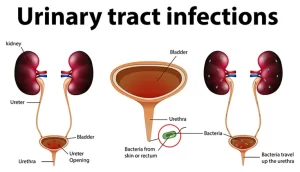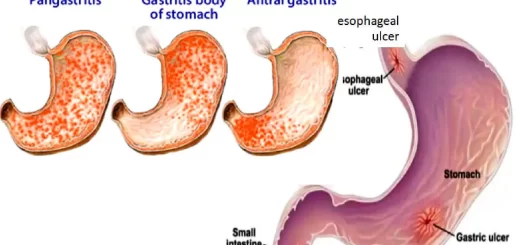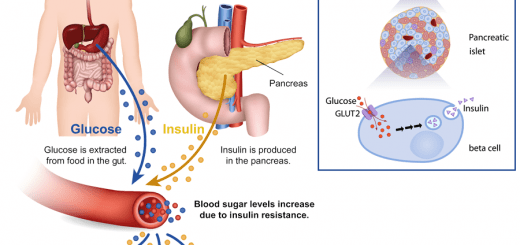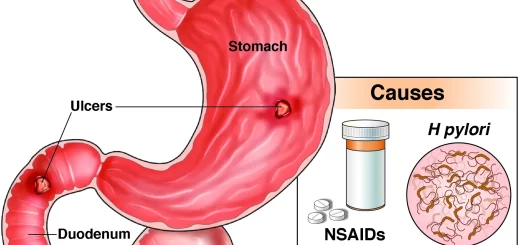Urinary tract infection Treatment, Acute Pyelonephritis, Acute Cystitis, and Acute Bacterial Prostatitis
A urinary tract infection is an infection in any part of your urinary system, This system includes your kidneys, ureters, bladder, and urethra, Most infections involve the lower urinary tract — the bladder and the urethra, Causes of Urinary Tract Infections are bacteria, most commonly E. coli.
Symptoms of Urinary Tract Infection (UTI)
Symptoms of a UTI can vary depending on where the infection is located.
- Lower UTI (bladder infection): Frequent urination, Urgent need to urinate, Pain or burning sensation when urinating, Pelvic pain, Cloudy or bloody urine, and Strong-smelling urine.
- Upper UTI (kidney infection): Back or side pain, High fever, Chills, Nausea, and Vomiting.
Risk Factors
Several factors can increase your risk of developing a UTI, including:
- Being female.
- Sexual activity.
- Menopause.
- Using a diaphragm for birth control.
- Having a history of UTIs.
- Kidney stones.
- Weakened immune system.
Causes of Urinary tract infection
Most UTIs are caused by bacteria, often E. coli, Bacteria can be introduced into the urethra during sexual intercourse, Stones can block the urinary tract, allowing bacteria to multiply, People with weakened immune systems are more susceptible to UTIs, Long-term use of catheters can increase the risk of infection.
Diagnosis of Urinary tract infection
- Urine test: A urine sample is analyzed for bacteria and other signs of infection.
- Blood test: A blood test can check for signs of a kidney infection.
- Imaging tests: In some cases, imaging tests like ultrasound or CT scan may be needed.
Treatment of Urinary tract infection
- Antibiotics: Most UTIs are treated with antibiotics. It’s essential to complete the entire course of antibiotics, even if symptoms improve.
- Pain relievers: Over-the-counter pain relievers can help with discomfort.
- Drinking plenty of water helps flush out bacteria.
- Home remedies can help relieve discomfort.
- Apply a warm compress to your lower back.
Prevention
Several steps can help prevent UTIs:
- Wipe from front to back: This helps prevent bacteria from the anus from entering the urethra.
- Urinate after sexual intercourse: This helps flush out bacteria.
- Drink plenty of fluids: Staying hydrated helps prevent UTIs.
- Avoid irritating substances: Some products can irritate the urinary tract, so it’s best to avoid them.
- Avoid tight-fitting clothing.
Acute Pyelonephritis
- Etiology: E. coli, Klebsiella (gram-negative organisms).
- Route of infection: ascending infection (neglected cystitis→ ureter → renal pelvis → calyces → collecting ducts→ ureter collecting → renal parenchyma).
- Pathology: kidney parenchyma is edematous and swollen with congested mucosa of the renal pelvis and calyces. Acute inflammatory reaction of the parenchyma and mucosa is noted microscopically.
- Clinical Presentation: dull aching renal pain, fever, malaise, nausea and vomiting.
- Investigations: urine analysis: pyuria; blood count: leukocytosis (if the infection is severe) and urine culture and sensitivity.
- Treatment: ampicillin and quinolones are usually effective and should be given immediately without waiting for the culture results. They can be changed later if urine culture results show drug resistance.
- Prognosis: excellent if treated promptly. Neglected cases can develop septicemia and septic shock which can be fatal.
Acute Cystitis
- Etiology: E. coli, klebsiella.
- Route of infection: ascending infection from the urethra.
- Incidence: more common in females because the urethra is short and in close proximity to the vagina.
- Pathology: the bladder urothelium is congested, edematous, and infiltrated by acute inflammatory reaction (neutrophils).
- Clinical Presentation: irritative urinary symptoms caused by inflammation of the sensory trigonal nerve fibers (burning, urgency, and frequency day and night).
- Urine Analysis: pyuria, hematuria (usually microscopic).
- Treatment: ampicillin and quinolones are usually effective and should be given immediately without waiting for the culture results.
- Prognosis: excellent if treated promptly. Neglected cases progress to chronic cystitis.
Acute Bacterial Prostatitis
- Etiology and Route of Infection: ascending infection from the urethra by gram-negative organisms (E. coli, klebsiella). Less commonly, hematogenous spread of infection by gram-positive organisms (staph aureus).
- Pathology: Stromal edema and hyperemia with infiltration of acute inflammatory cells (neutrophils).
- Clinical Presentation: acute onset of fever with severe irritative + obstructive urinary symptoms (the irritative symptoms are caused by the acute inflammatory process; while the obstructive symptoms are caused by the markedly swollen prostate from edema and congestion). The prostate is extremely tender by digital rectal examination (DRE).
- Investigations: pyuria, leukocytosis. Prostatic massage to obtain prostatic fluid for culture and sensitivity test) is contraindicated as it can exacerbate septicemia and septic shock.
- Complications: development of a prostatic abscess. It is diagnosed by ultrasound or CT scan. It is surgically drained by a perineal or transurethral approach.
- Treatment: (parental) ampicillin, quinolones, and cephalosporins are usually effective.
- Prognosis: excellent with proper treatment.
Acute Epididymo-Orchitis
- Etiology and Route of Infection: E. coli proteus or pseudomonas. Caused by direct infection from the urethra or prostate. This may occur after urethral instrumentation eg. Catheterization or endoscopy.
- Pathology: the epididymis and testis are markedly swollen and indurated. They are infiltrated by acute inflammatory cells (neutrophils).
- Diagnosis: an acute onset of a severely painful, huge, tender, and firm scrotal swelling. (Colored Doppler ultrasound of the swelling reveals increased vascular circulation which is consistent with an acute inflammatory process.
- Differential Diagnosis: torsion of the testis. Secondary torsion of the spermatic cord results in complete occlusion of the testicular vessels. Testicular infarction occurs if surgical de-torsion is not done within 4 hours. The clinical presentation is exactly the same as with acute epididymo-orchitis. Colored Doppler ultrasound shows loss of testicular vascularity.
- Treatment: appropriate antibiotics, bed rest and pain killers with excellent prognosis.
You can subscribe to Science Online on YouTube from this link: Science Online
You can download Science Online application on Google Play from this link: Science Online Apps on Google Play
What are urinary tract infections?, kidney problems, Urinary retention, and Bladder stones
Functions of Kidneys, Role of Kidney in glucose homeostasis, Lipid & protein metabolism
Histological structure of kidneys, Uriniferous tubules, and Types of nephrons
Urine formation, Factors affecting Glomerular filtration rate, Tubular reabsorption and secretion
Urinary passages function, structure of Ureter, Urinary bladder & Uvulae vesicae
Urinary system structure, function, anatomy, organs, Blood supply, and Importance of renal fascia
Urinary bladder structure, function, Control of micturition by Brain, and Voluntary micturition




